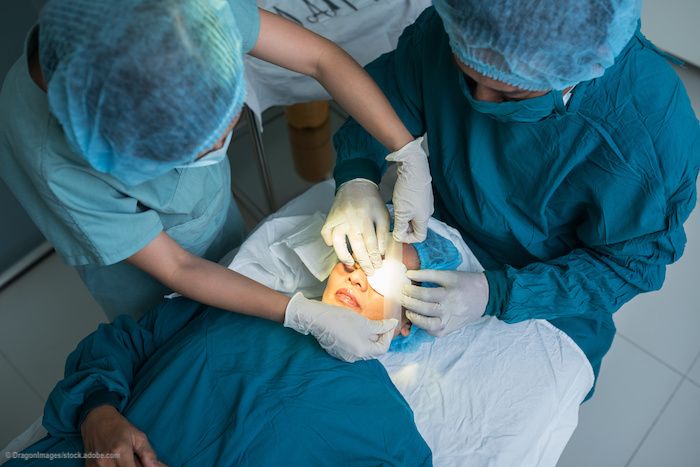Article
Cataract surgical experiences of residents: Exploring gender differences
Author(s):

Female ophthalmology residents performed both significantly (p < 0.001) fewer cataract surgeries and fewer total procedures (p < 0.001) compared with the male residents from 2005 to 2017.
There is no argument with the old adage “practice makes perfect.” This is especially true for ophthalmology residents. The results of studies both older and more recent all point in the same direction: operating room performance by ophthalmology residents improves with increasing numbers of surgeries.
However, a recent study found a highly noteworthy finding, i.e., that female residents performed significantly fewer cataract surgeries and significantly fewer total numbers of procedures compared with the male residents from 2005 to 2017 (p < 0.001 for both comparisons).
And this is despite that fact that the numbers of male and female residents were similar in ophthalmology training programs.
This raises the questions: While the numbers of men and women in the residency training programs were similar, was the surgical experience the same?
This finding emerged from a retrospective longitudinal analysis of recent case logs performed by Dan Gong, MD, and colleagues. The authors reported their findings in in JAMA Ophthalmol. 2019;137:1015-1020. doi:10.1001/jamaophthalmol.2019.2427.
RELATED: 9 best practices in refractive-cataract surgery planning
All 119 ophthalmology residency programs in the United States were asked to participate. Participation was anonymous, and according to study authors, the following data were collected for each graduating resident:
- graduation year,
- resident gender,
- number of cataract procedures performed as the primary surgeon,
- total number of procedures performed, and
- parental leave status.
The main outcome measures were the mean volumes of cataract surgeries and total procedures, resident gender, and maternity or paternity leave.
Of the programs contacted, 24 (20.2%) residency programs provided data on 1,271 residents, of which 815 (64.1%) were men and 456 were women (35.9%) who graduated from 2005 to 2017.
The authors reported that the male residents performed more cataract surgeries than the female residents (mean, 176.7 versus 161.7, respectively); the male residents also performed a higher mean number of total procedures (509.4 versus 451.3, respectively). Eighty-five male residents and 71 female residents took parental leave.
Interestingly, the male residents who took parental leave performed a mean of 27.5 more cataract surgeries compared with the men who did not take parental leave, the female residents who took parental leave performed a similar number of surgeries to those who did not take parental leave.
Beginning in 2005, each subsequent year saw an increase in the number of cataract surgeries performed by each resident, although there was no significant (p = 0.11) gender difference identified.
However, there was a significant (p = 0.008) gender difference in the total volume of procedures performed; over time, the male residents performed more surgeries than the female residents and that gap widened over time.
RELATED: These 3 things are part of a cataract surgeon's signature
Considerations
The differences in the numbers of cataract surgeries performed by the female residents compared with the male residents ranged from 7.8 to 22.2 fewer, and the differences in the total numbers of procedures performed by the female residents ranged from 36.0 to 80.2 fewer.
The numbers of cataract surgeries performed by the male and female residents, however, more than met the requirements of the Accreditation Council for Graduate Medical Education, the authors pointed out.
The growing gap in the total number of procedures over time was of special interest to the study investigators.
They commented, “One concerning trend that deserves special mention is the growing gap in total procedural volume between male and female residents as time progresses. Although we are encouraged that [the] overall case volume increased from 2005 to 2017, it is unclear why the increase asymmetrically affects male and female residents.”
The parental leave was found not to affect the total numbers of procedures performed by the male and female residents.
The authors suggested that “if residents are more likely to take parental leave in their third year, taking leave would have less of an effect on procedural volume during the first and second years of residency when many laser and other procedures are performed.”
RELATED: 7 pearls for beginning and seasoned surgeons
The investigators recommended that each residency program director evaluate the case volumes of the male and female residents and if there were differences found the directors should examine if the policies of the programs differ for men and women. Some considerations could include the manner in which a program helps residents with their case volume when taking parental leave, adjusting rotation schedules based on the timing of the parental leave to minimize the disruptive effect on the residents’ education, and determining how and when the attendings pass on surgical cases to the residents.
The authors suggested that further studies with more participating residency programs be undertaken to confirm the current study data.
The authors concluded, “Female residents performed 7.8 to 22.2 fewer cataract operations and 36.0 to 80.2 fewer total procedures compared with their male counterparts from 2005 to 2017, a finding that warrants further exploration to ensure that residents have equivalent surgical training experiences during residency regardless of gender.”
RELATED: 10 effective habits of a cataract surgeon
Newsletter
Don’t miss out—get Ophthalmology Times updates on the latest clinical advancements and expert interviews, straight to your inbox.




